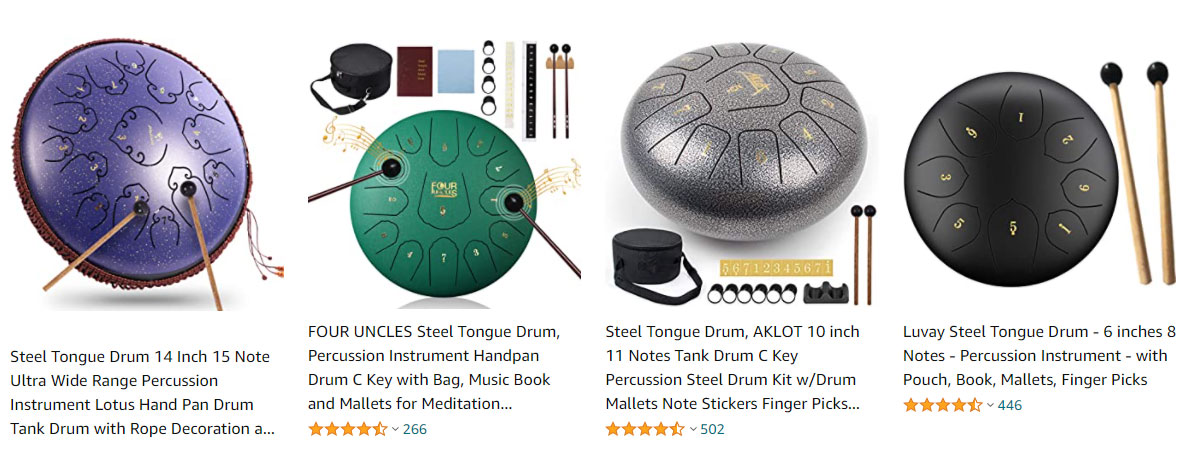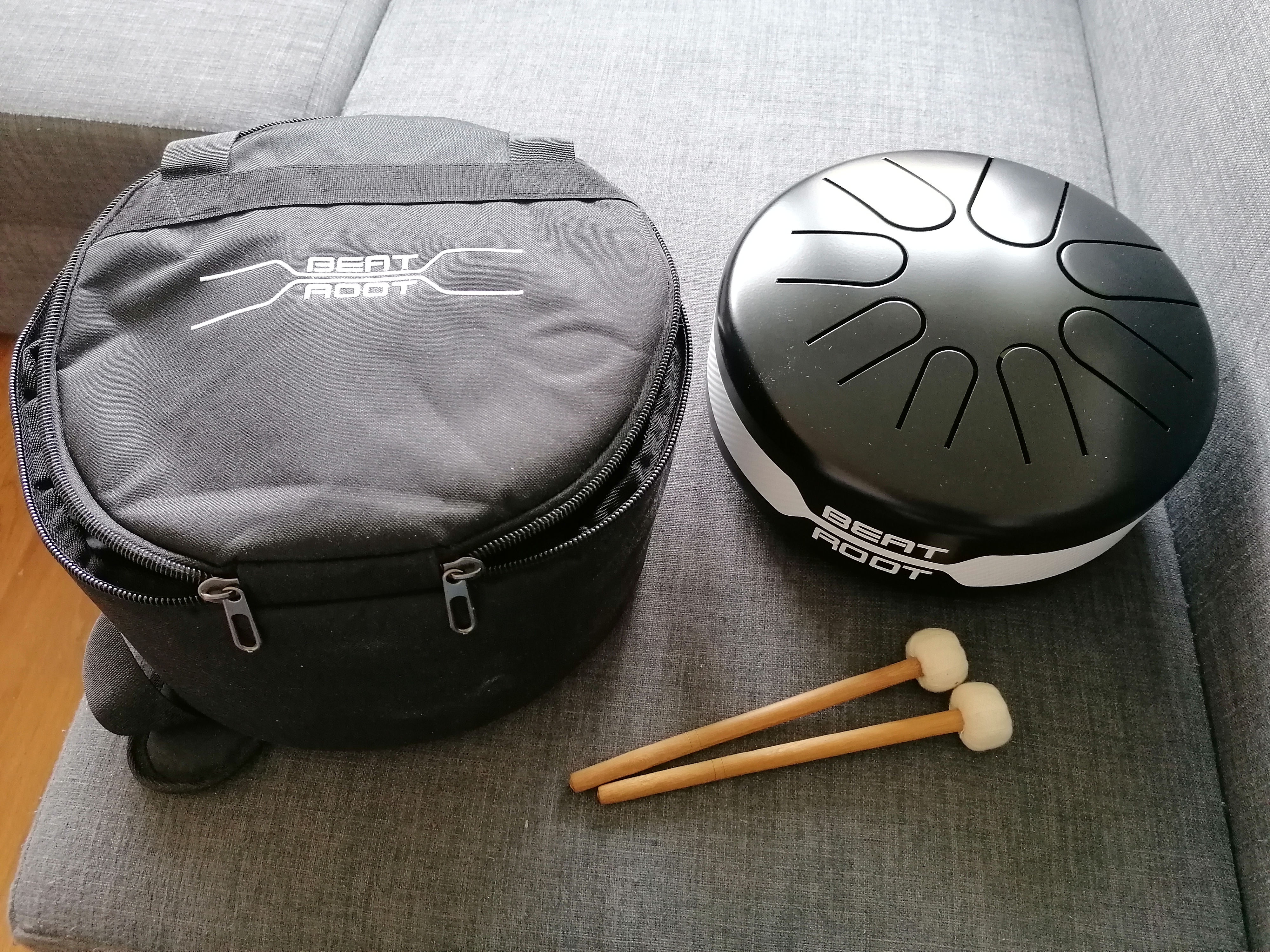Tongue drum
In this article, we reveal everything you need to know about the Zen instrument Tongue Drum, including its history, how it works and how to play it.
Introduction to the Tongue Drum
Music is one of the oldest art forms on the planet. Thousands of years ago, our ancestors made instruments from logs, bamboo, sticks and even animal bones. Even today, we are still being creative and finding new ways to create beautiful melodies.
An example of a recently developed Zen instrument is the tongue drum, also known as the tongue drum, steel tongue drum, hank drum, hand drum or tongue drum. It is a percussion instrument made from propane cylinders and has become increasingly popular since its creation in the late 2000's due to its relaxing sounds, ease of play, portability and unique UFO-like appearance.
There is also another version of the tongue drum made of wood. These drums look like long rectangular boxes.
Tongue drums are charming instruments that can be played by anyone and can be found in many different environments, from a therapist's office to a classroom to a meditation session.
If you are not yet familiar with the tongue drum, we have created this guide to explain and explore the ever-expanding world of the tongue drum and their peaceful notes.
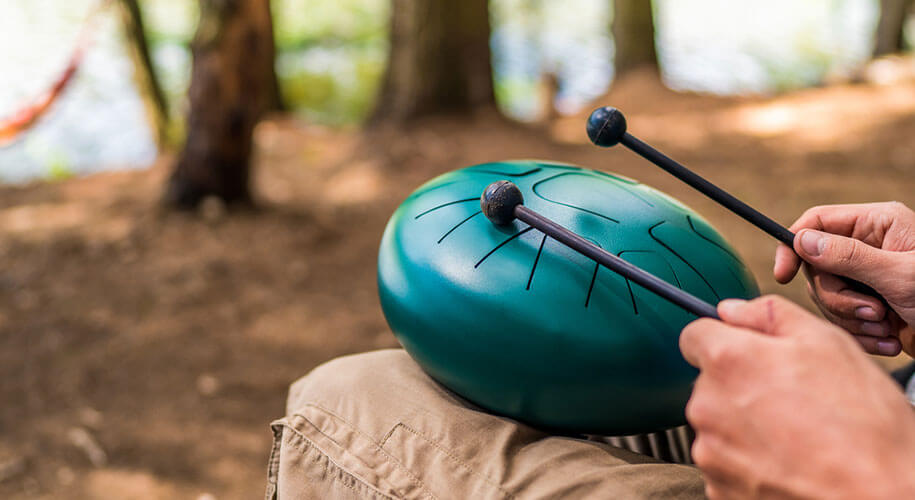
What is a Tongue Drum?
The tongue drum, also known as a steel tongue drum, tank drum or hip drum, is a relatively new instrument belonging to the idiophone family of percussion instruments.
An idiophone is an instrument that produces sound by the vibration of the instrument itself. Tongue drums are similar to and inspired by other percussion instruments, such as the hanging drum, slit drum, whale drum, and tambiro.
Today, however, they are known as such, as they have become very popular for meditation music, yoga practice and sound therapy. These drums, which look a bit like UFOs, are not from another planet, but the music they can create is otherworldly!
The tongue drum is a great instrument for anyone who wants to be creative, play, listen to beautiful melodies and relax. It can be enjoyed by everyone, at almost any age.
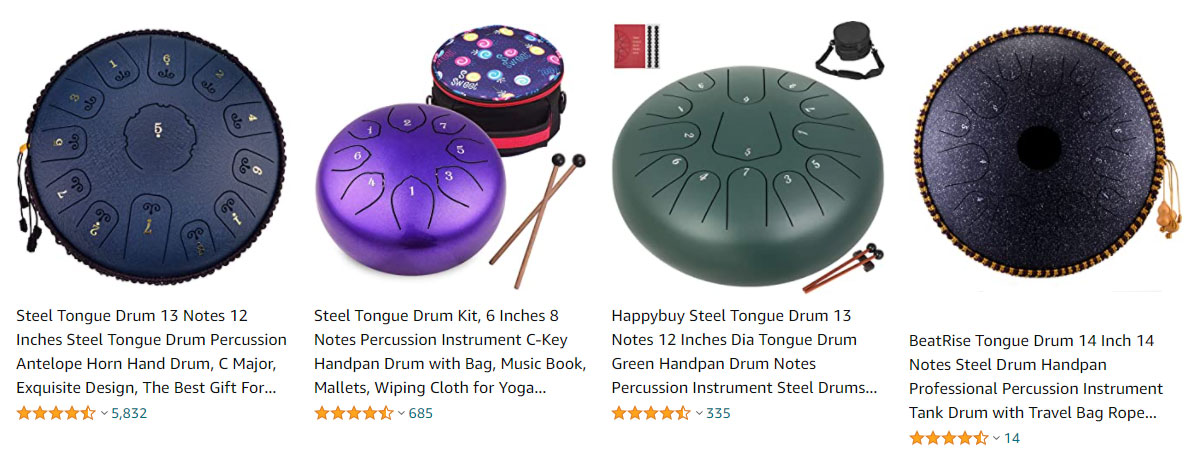
The History of the Tongue Drum
According to archaeological findings, idiophones are one of the oldest types of musical instruments. Thousands of years ago, our ancestors in Africa, Southeast Asia and Oceania carved or built these instruments from bamboo or wood.
These "slotted drums" look like a box and have one or more slots on top. Two examples of this type of instrument are the African wooden drum and the Aztec teponaztli drum, the oldest ancestors of the tongue drum.
So while some of today's tongue drums are handcrafted from various types of wood, the most popular tongue drums on the market are made from steel or metal alloy. In this sense, tongue drums are more similar to Caribbean steel drums, hang drums, whale drums and the Felle Vega tambiro.
In fact, it was the tambiro and whale drum that inspired tongue drum inventor Dennis Havlena to use an empty 20-pound propane tank to build his version of a drum that sounds like a hanging drum.
In 2007, Havlena cut out the bottom of a propane tank, then created a circular cross-shaped pattern on the bottom where he cut out the "tongues" in a radial pattern.
Depending on the manufacturer, there are typically seven to ten tongues, but there are designs with eleven to thirteen. The bottom of the reservoir then becomes the top surface of a new instrument. This is how Havlena created the instrument he named the "Hank Drum", after a tank that he had built in the past. named after a propane tank turned into a drum, inspired by the sound pattern of a suspended drum.

Unlike hanging drums, which are rare and expensive, steel tongue drums are smaller, more portable, and more accessible to more people.
Tongues, of course, are the source of the tongue drum's name, but what exactly do they do?
In a way, tongues are like the strings on a guitar or the keys on a piano. They are what allow the instrument to create rhythms or melodies. Each tongue is tuned to a specific note. The weight, width and length of the tongue determine the sound and pitch of the note.
To play a note, you strike a tab with your fingers, hands or mallet. The drum itself amplifies the sound that is released through the slots in the tongues. When you strike more than one tongue at a time, you create a chord.
By mixing and matching notes and chords on the steel tongue drum, you can create beautiful melodies. The best part is that you don't need any experience or knowledge of musical instruments to make your tongue drum sound good! This is due to the special way the drums are tuned.
The benefits of the Tongue Drum
It is recognized that music has many virtues on our health and our mental. Playing the tongue drum will take you on a journey of calm and serenity.
- Reduces stress and anxiety of daily life
- Promotes better sleep and reduces insomnia
- Facilitates interactions with people with autism or certain illnesses
- Helps to improve concentration and reduce mind wandering
- Encourages relaxation and helps to let go
- Reduces pain in chronic illnesses
- Brings joy and a sense of well-being.
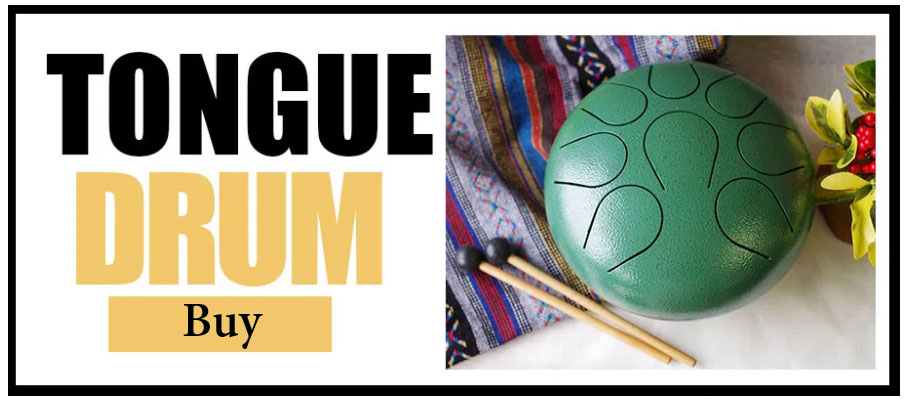
What tones does the tongue drum emit?
So how can a Zen instrument be described as "so easy that anyone can play it", as some have described the tongue drum?
It is because of the usual pentatonic scale used with steel tongue drums! The pentatonic scale is a musical scale with five notes per octave. A scale is "a series of notes that differ in pitch according to a specific pattern". With the pentatonic scale, each note within the octave blends well together and you can play them in any order to create a pleasing melody.
In other words, there is no wrong note or chord that can be produced. Each note will blend into the harmony, making it a very easy instrument to pick up and play, even without any knowledge of music theory or experience playing an instrument.
It is important to note that the tongue drum can also be made to have different scales. The most popular scales for tongue drums, in addition to the pentatonic scale, are: the diatonic scale, the chromatic scale, the minor or major scales of all notes or Akebono.
- Tongue drums tuned to the diatonic scale have a scale that consists of five whole steps and two half steps (semitones) in each octave.
- A chromatic scale is a twelve tone scale with twelve pitches.
- The akebono scale is a musical scale used in traditional Japanese music and is most similar to the diatonic scale.
Although these scales have more notes, the instrument does not become more complicated or difficult to play. On the contrary, it gives the drum a wider range of new note combinations.
Usually, the manufacturer indicates the scale to which the tongue drum is tuned. These tunings tend to be static; however, if you have some knowledge of music theory and can use an electronic chromatic tuner, you also have the option of purchasing a tunable tongue drum.
Tunable tongue drums allow the player to change the scale of the instrument. This is often done by adding weights, usually neodymium magnets, under the tongues. Having a tunable tongue drum, or even a double-sided tongue drum, gives you a wider range of notes to play and create.

Some tongued drums are also associated with a specific pitch, or the degree of sharpness or attenuation of a sound. Most often, if a tongue drum has a specific pitch, it will be manufactured to possess a frequency of 432 Hz, also known as the Verdi pitch.
The frequency of 432 Hz is said to be the vibrational frequency of the universe. Tongue drums of this frequency are normally tuned to the C major scale.
Other common frequencies that you can find in tong drums are 440 Hz and 444 Hz. These pitches can have different meanings to the musician and we will come back to them later.
Various manufacturers and craftsmen make pre-tuned tong drums to the scale or pitch of their choice. However, many of these manufacturers and craftsmen are happy to work with customers to tune the drums to the musician's wishes.
Are there different types of Tongue Drum?
There are several types of flip-flop drums that differ in their composition. They can be made of metal, steel, alloy steel or wood.
Metal, steel and alloy steel drums are the most similar in sound, size and shape. Metal tongue drums are often coated with an anti-corrosion coating that protects the drum from scratching.
Metal drums are also more customizable, as they can be painted different colors and engraved with different designs.
In contrast, the wooden tongue drum usually has a more natural look and is shaped like a box rather than a round circle. They can be made from many different types of wood, such as red elm, spruce, canary wood, mahogany, cedar, etc. Craftsmen tend not to paint the wood, but seal it with natural oils and beeswax to protect and enhance the natural beauty of the wood used.
When choosing which type of tongue drum is right for you, try listening to different YouTube videos and choose the one that looks most appealing to you. Whether it's steel or wood, they will all sound beautiful.
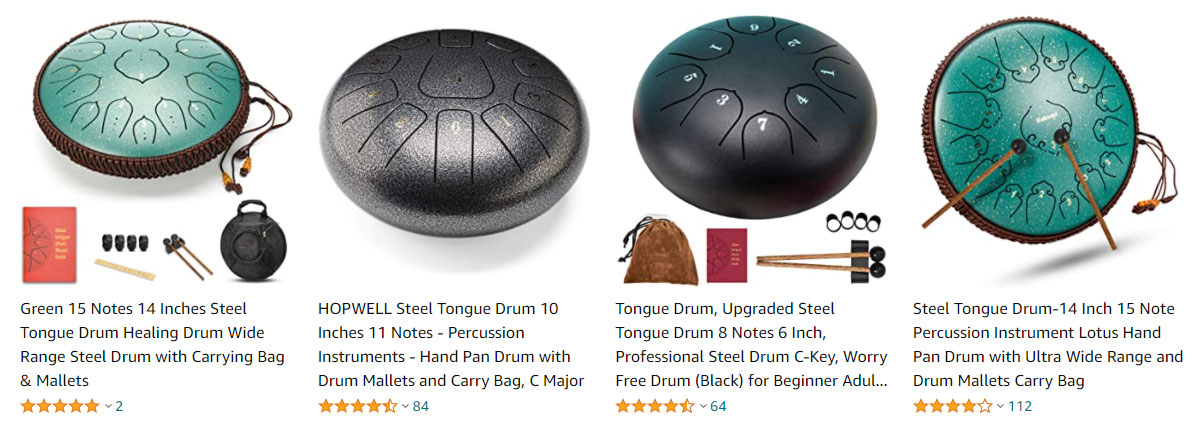
What are the different uses of the tongue drum?
There are many different situations and reasons why one might want to play a tongue drum. Not only is it a great Zen instrument, but it's also a tool for finding inner peace. Whether you're on your way to a jam session with friends or a therapy session with a medical professional, you may encounter the soothing and mystical sounds of a steel tongue drum.
The tongue drum has gained such popularity in large part due to its quiet, peaceful notes. Their gentle melodies have made them an instrument of well-being. As such, tongue drums are excellent musical companions for meditation practice.
Meditate with the Tongue Drum
Their pleasant and relaxing sounds create a soothing environment. The combination of meditation and tongue drums can be restorative. When you drum, you should be able to regulate your breathing according to the rich melody you are playing. When you play with intention, you are able to breathe with intention as well.
The sounds also provide focal points for your attention, allowing you to concentrate while your body and mind relax and lose themselves in the sounds of the drum. While you meditate and play, feel free to chant a mantra or harmonize with your voice.
This method of meditation can bring you peace and enlightenment as you learn more about yourself and the world around you. If you would like to meditate with tongue drum music before investing in your own drum, there is plenty of free tongue drum music available on the internet.

Practicing Yoga with the Tongue Drum
Another way to cleanse the mind and soul with tongue drums is to integrate them into your yoga practice. Listening to tongue drums while doing yoga is beneficial to your mental, physical and spiritual health. As with meditation, adding a steel tongue drum to your yoga practice helps improve intentional breathing and gives you a focus for your attention.
Playing the Tongue Drum to Cleanse Your Chakras
Yet another way to use the tongue drum is for chakra cleansing. Chakra cleansing is very popular with instruments such as Tibetan singing bowls, tuning forks and now tongue drums.
However, not all tongue drums are ideal for chakra cleansing. Most of the time, people buy a special chakra tongue drum that has been designed for chakra healing and cleansing. To use a tongue drum to cleanse your chakras, you must play the note associated with each of the major chakras. Keep in mind that some chakras are said to have two notes, so different scales can serve the same purpose.
To cleanse the chakras with a tongue drum, simply begin by playing the note C on your drum and begin to meditate and focus on the location and well-being of your root chakra. Do the same for each of the chakras, from lowest to highest.
Music therapy with a Tongue Drum
Music therapy is another way to use the tongue drum. Music therapy and sound baths are both ancient and modern practices.
Sound baths, for example, although their exact origins are unknown, have been used since ancient times in many different cultures. Meanwhile, scientists and researchers have gained a better understanding of how sounds and vibrations can enhance our lives.
Certain vibrations can elicit physical and emotional responses. For example, certain vibrations "train" the brain. The frequency of the instrument and our brain waves can synchronize, allowing us to focus and relax better.
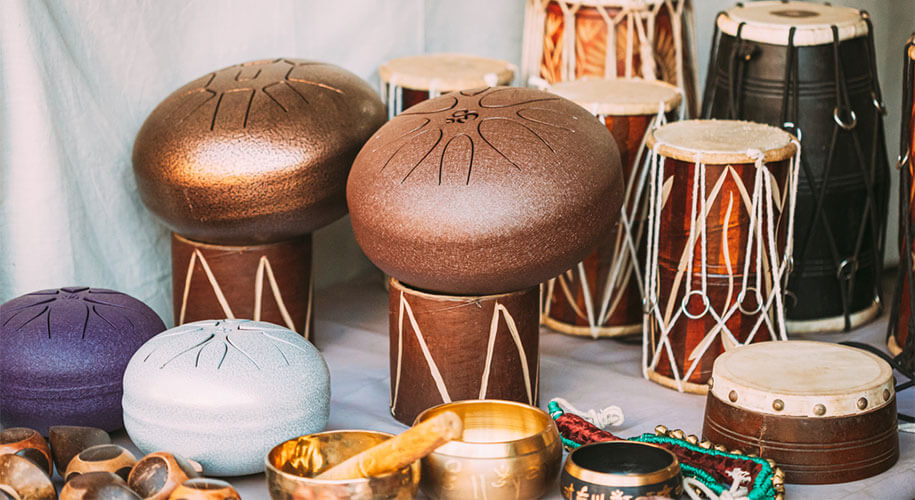
There are two types of music therapy: receptive music therapy and active music therapy.
In receptive music therapy, the tongue drum is played for the patient. While the patient listens, he or she may be asked to meditate, to focus on something specific or to close the eyes. This type of therapy can improve overall mood and reduce stress, anxiety and pain while promoting relaxation.
Active music therapy, on the other hand, involves the client playing a tongue drum. This type of therapy can also contribute to relaxation, but with the added benefit of patient participation. For this reason, tongue drums can also be incorporated into other types of therapy.
For example, occupational therapists and child behavior therapists may find tongue drums beneficial in their practice. Having the client play the tongue drum can help improve coordination, overcome physical challenges, promote self-expression, and inspire greater confidence in their abilities.
In addition, the soothing sounds of tongue drums make them an excellent choice for children and adults with special needs, such as autism, who are sensitive to loud or abrupt sounds.
Playing the Tongue Drum for fun
Finally, tongue drums can be used to create new musical compositions and are a great addition to a friendly jam session or drum circle. As mentioned earlier, the tongue drum's complementary scale allows it to play no "wrong" notes! This makes it an ideal instrument for being creative, creating new rhythms and having fun.
Where can you buy a Tongue Drum?
Today, tongue drums can be found and purchased in many different places. If you want to choose a tongue drum in person, your local music store may carry or be able to order the tongue drums you are interested in.
Not all music stores carry tongue drums, but if you can find a store that specializes in percussion instruments, they will likely have a few in stock.
Another way to choose a tongue drum in person is to get in touch with an artisan who makes tongue drums nearby. Many craftsmen who sell their tongue drums online are also open to visits or appointments for those interested in purchasing a tongue drum.
Finally, of course, you have the option of buying a tongue drum from home by shopping online. You can always order directly from a manufacturer's or craftsman's website or from a third party marketplace.
Tongue drums have gained popularity because of their affordability compared to another instrument called the hang drum. Hang drums have a very similar sound to the tongue drum, but they are often larger, louder, more expensive and harder to find. While a hang drum can cost thousands of dollars, you can find a steel tongue drum for less than $100.
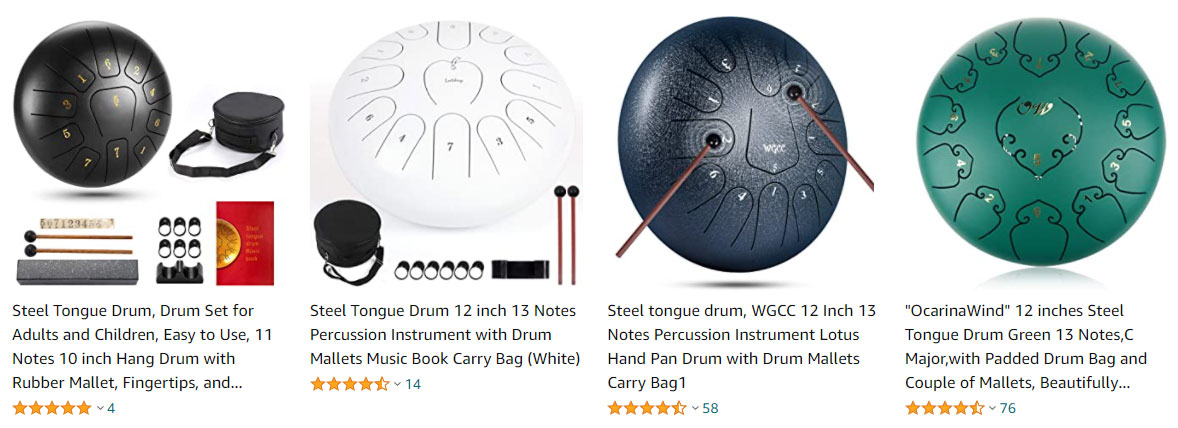
How to choose Tongue Drum?
When choosing the right tongue drum, there are several things to consider. First, the scale is an important feature to keep in mind when choosing the right tongue drum for you and your needs, as the scale determines the "feel" or "emotion" of the instrument when played.
As mentioned earlier, tongue drums are available in the following popular scales: pentatonic, diatonic, chromatic, C major, E minor or Akebono.
However, there are even more options than these, so it's important to do your research before deciding which scale you prefer. There are some general rules for judging scales:
- Major scales are generally considered more cheerful and joyful. For example, a C major scale is very cheerful.
- On the other hand, minor and high scales are considered to be more somber, sad or pensive. For example, the C sharp scale is considered very melancholic.
- The Akebono scale originated in Japan and is known to have a more meditative or Zen tone.
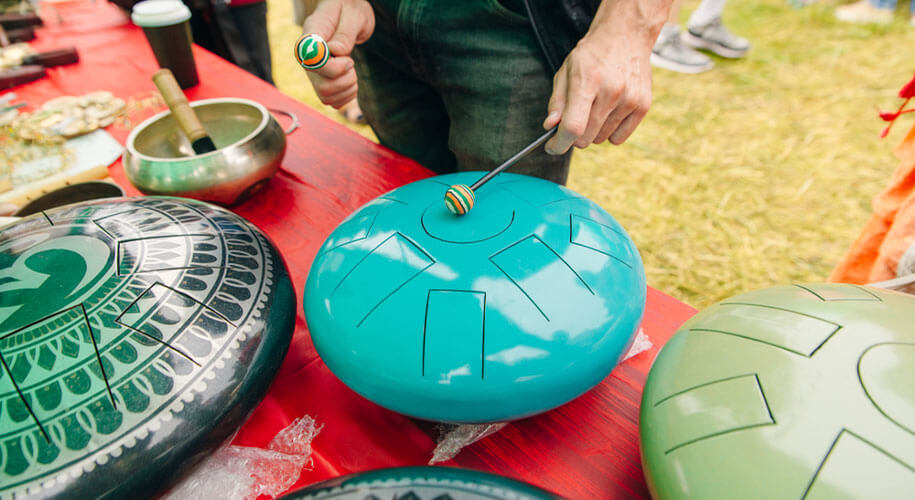
If you have a specific mood or emotion you want to associate with your tongue drum, you can use the guides above to help you choose the right drum.
If you don't have one, try listening to different scales played in YouTube videos. With this method, choose a scale that resonates with you.
If you're stuck between different scales and can't decide on one, you might want to buy a tunable or double-sided tongue drum. Some tunable tongue drums can play up to six scales using powerful magnets. These drums can switch between scales in seconds, making them a great choice for anyone who likes to experiment with sound and different chords.
If you purchase a tunable tongue drum, it is important that you also purchase an electronic tuner, which will help you get the correct notes.
Buying a Tongue Drum: Its Frequency
Another characteristic of steels stong drums that you might want to consider is their pitch, or frequency. The standard tunings are 432 Hz, 440 Hz and 444 Hz.
• If you want soothing or grounding notes, the lowest pitch, 432 Hz, will meet your needs.
• 440 Hz is a standard tuning for musicians, so it's the best choice if you plan to play your drum with other instruments.
• Finally, there is the top tone, 444 Hz. This tone is exhilarating and useful for releasing tension.
Buying a Tongue Drum: Aesthetics
Another thing to consider when buying a tongue drum is aesthetics. Many tongue drums come in different bright colors, antique patinas, and even have beautiful and unique engraved designs on the top of the drums.
Sometimes the tongues are even shaped and stylized to form images, like lotus flowers. Other drums have sides decorated with rope. This can make the drums easier to hold, but also makes them beautiful to look at, even when not in use.
Buying a Tongue Drum: for beginners or advanced
Finally, when choosing the right tongued drum, you need to consider who you are buying it for. If you are a beginner or buying one for a beginner, a simple drum with fewer notes is a great option!
If you're buying a drum for a child, a small drum in the 5-8 inch range should be fine. Drums can be as small as 5 inches in diameter and as large as 20 inches, so it's important to note the size of your drum before you buy.
Weight is another consideration to keep in mind, especially if you are buying for a child. Lightweight drums are suitable for children and musicians who plan to travel and carry their drum often.
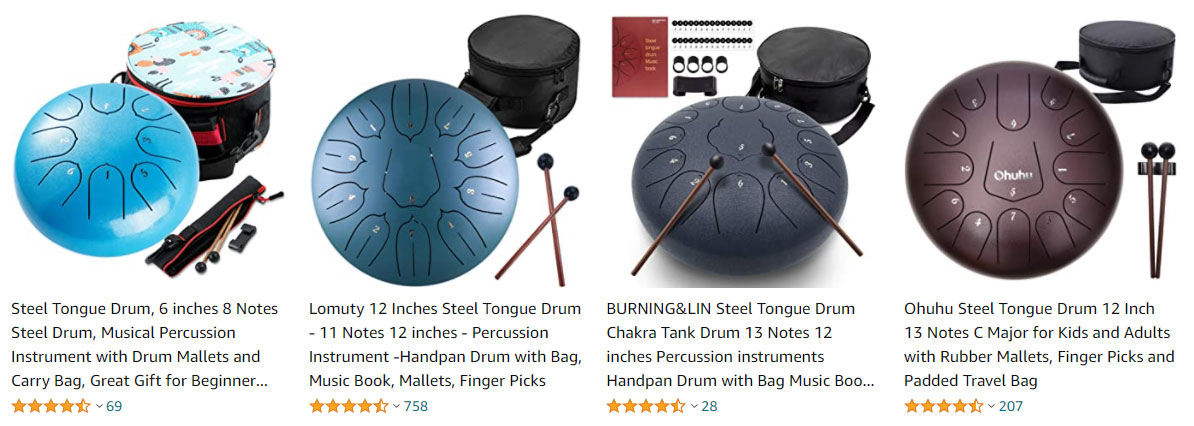
How to take care of your tongue drum
Maintaining your steel tongue drum is easy! Simple precautions and being aware of what your tongue drum can and cannot do are very helpful. When playing your tongue drum, keep the following recommendations in mind:
- Use appropriate force, either with your palm or with a mallet.
- When you play, your wrist should produce the motion, not your whole arm or elbow.
- Do not play the middle of the tongue with your fingers. Instead, focus on the sides and lower half of the tongue.
- Avoid wearing rings or bracelets while playing.
When not playing your tongue drum, store it in a safe, dry place inside. They should not be left outside or exposed to the weather.
When transporting your tongue drum, we strongly recommend using a padded protective case. Use of the case will prevent the tongue drum from being scratched or accidentally dropped.

If a problem occurs with your tongue drum, you need to identify it so you can determine the source. For example, if you hear a buzzing sound, debris may have become lodged between the slots.
To clear the slots, simply use a thick piece of paper to clean between the tab and the rest of the drum.
If your drum is out of tune or can no longer be tuned, several things may have happened. If you dropped your drum recently, it may have chipped, cracked or dented, causing it to go out of tune. If this is the case, you can send the drum back to the manufacturer for repair or you may need to replace it with a new drum.
Another reason drums go out of tune is improper use by playing too hard. Too much force can dent, bend or warp the tabs.
Finally, to clean your tongue drum, simply dust it with a soft or microfiber cloth.
How do you play the Steel Tongue Drum?
Tongue drums are played either with the hands or with mallets or sticks. Both methods of playing have their advantages and disadvantages.
Playing the Tongue Drum with mallets
When playing with mallets or sticks, the mallets bounce off the drum easily, resulting in a clearer, deeper and more resonant sound. The amplification of sound is perhaps the most noticeable difference when playing with mallets. Your tongue drum will sound much louder when you use mallets. Some people, however, prefer to play their tongue drums with their hands.
Playing the Zen instrument with your hands
When a person plays the tongue with their hands, they use their fingers, palms and the heel of their hand to create melodic rhythms. Playing with your hands can strengthen your connection to your drum and give you more freedom to play. Playing a tongue drum with your hands is considered the most technical and difficult option, but with practice and patience, anyone can play with their hands!
Some people find that using rubber picks, sleeves, or rubber buttons helps them play the drum by hand. These accessories increase the volume of the drum while giving you the agility, variety and freedom of hand drumming. The picks can also prevent injury and pain in your fingers after playing for extended periods.
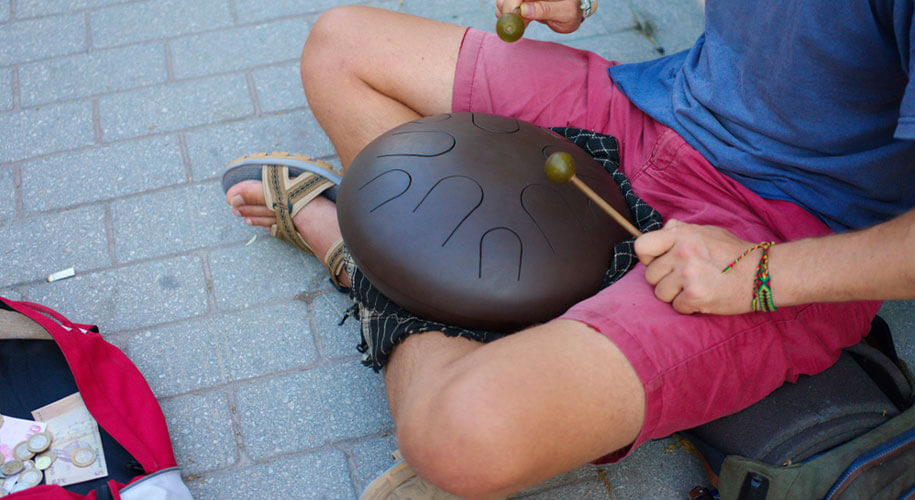
How to position the Tongue Drum?
To play your tongue drum, you can place the drum on your lap. A stand is not necessary, although some people prefer to use one or place their drum on a flat surface.
If you wish to use a stand or play the drum on a table or floor, be sure to use a stand recommended by your drum manufacturer. As for playing on a flat surface, some manufacturers provide their drums with rubber feet, which makes playing easier and does not affect the sound quality of the instrument.
However, most people prefer to play on their knees, as they are closer to the instrument and its vibrations
When playing the drum on your lap, there is no "wrong" way to position the tongue drum, but there is a position that makes playing the instrument easier.
By placing the lowest note closest to your body, you will be able to move up the scale in a circular order starting from the left.
If it helps you remember where the notes are, many tongue drums come with numbered stickers that you can use to identify the notes on the drum. These stickers are also useful when you are playing music, as they allow you to easily follow the "sheet" of music.
If you are a complete beginner to the tongue drum or any other musical instrument, we have compiled some tips and exercises to help you get the most out of your tongue drum!
Conclusion
What makes the tongue drum so great are the effects that anyone can experience while playing or listening to its peaceful tune.
By playing a tongue drum, a beginner, amateur, or professional musician can unleash creativity, boost concentration, and eliminate anxiety and stress. Tongue drums are perfect for meditation, yoga practice, and even emotional healing.
Whether you buy a tongue drum from a craftsman or an online manufacturer, know that what you're investing in is more than just an instrument - it's a way to relax, play and reconnect with yourself.
Get a tongue drum and start playing today!
